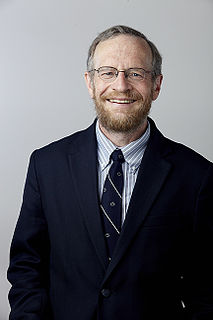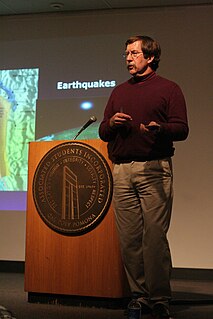
Frank Press was an American geophysicist. He was an advisor to four U.S. presidents, and later served two consecutive terms as president of the U.S. National Academy of Sciences (1981–1993). He was the author of 160 scientific papers and co-author of the textbooks Earth and Understanding Earth.

The Geological Society of America (GSA) is a nonprofit organization dedicated to the advancement of the geosciences.

Don Lynn Anderson was an American geophysicist who made significant contributions to the understanding of the origin, evolution, structure, and composition of Earth and other planets. An expert in numerous scientific disciplines, Anderson's work combined seismology, solid state physics, geochemistry and petrology to explain how the Earth works. Anderson was best known for his contributions to the understanding of the Earth's deep interior, and more recently, for the hypothesis that hotspots are the product of plate tectonics rather than narrow plumes emanating from the deep Earth. Anderson was Professor (Emeritus) of Geophysics in the Division of Geological and Planetary Sciences at the California Institute of Technology (Caltech). He received numerous awards from geophysical, geological and astronomical societies. In 1998 he was awarded the prestigious Crafoord Prize by the Royal Swedish Academy of Sciences along with Adam Dziewonski. Later that year, Anderson received the National Medal of Science. He held honorary doctorates from Rensselaer Polytechnic Institute and the University of Paris (Sorbonne), and served on numerous university advisory committees, including those at Harvard, Princeton, Yale, University of Chicago, Stanford, University of Paris, Purdue University, and Rice University. Anderson's wide-ranging research resulted in hundreds of published papers in the fields of planetary science, seismology, mineral physics, petrology, geochemistry, tectonics and the philosophy of science. He continued to work and publish until his death. His widely known textbooks, Theory of the Earth, and New Theory of the Earth are regarded by colleagues as compelling syntheses of the origins of the Earth and its inner workings by one of the great geophysical authorities of our time.

The Navajo Sandstone is a geological formation in the Glen Canyon Group that is spread across the U.S. states of southern Nevada, northern Arizona, northwest Colorado, and Utah as part of the Colorado Plateau province of the United States.

A clastic dike is a seam of sedimentary material that fills an open fracture in and cuts across sedimentary rock strata or layering in other rock types. Clastic dikes form rapidly by fluidized injection or passively by water, wind, and gravity. Diagenesis may play a role in the formation of some dikes. Clastic dikes are commonly vertical or near-vertical. Centimeter-scale widths are common, but thicknesses range from millimetres to metres. Length is usually many times width.

GSI3D is a methodology and associated software tool for 3D geologic modeling developed by Hans-Georg Sobisch over the last 20 years initially in collaboration with the Geological Survey of Lower Saxony (LBEG) and the Oldenburg-Ostfriesland Waterboard (OOWV) in Germany and from 2006–2010 in collaboration with the British Geological Survey. GSI3D has been further developed and is now solely available as INSIGHT's SubsurfaceViewer MX. The software is written in Java and data is stored in extensible mark-up language XML.
Burrell Clark Burchfiel is an American structural geologist. Born in Stockton, California, he earned his Ph.D. in 1961 at Yale University. His first academic appointment was to the Geology department at Rice University. He is the Schlumberger Professor Emeritus of Geology at MIT. Research interests: Origin, development, and structural evolution of the continental crust. His current work involves study of the geological history and evolution of the Tibetan plateau.

Richard Blane Alley is an American geologist and Evan Pugh Professor of Geosciences at Pennsylvania State University. He has authored more than 240 refereed scientific publications about the relationships between Earth's cryosphere and global climate change, and is recognized by the Institute for Scientific Information as a "highly cited researcher."
Scientific literacy or science literacy encompasses written, numerical, and digital literacy as they pertain to understanding science, its methodology, observations, and theories. Scientific literacy is chiefly concerned with an understanding of the scientific method, units and methods of measurement, empiricism and understanding of statistics in particular correlations and qualitative versus quantitative observations and aggregate statistics, as well as a basic understanding of core scientific fields, such as physics, chemistry, biology, ecology, geology and computation.

R. Timothy Patterson is a professor of geology in the Department of Earth Sciences at Carleton University, Ottawa, Ontario, Canada. He is a Canadian researcher with specialization in paleolimnology, paleoceanography and paleoclimatology. He founded and is co-Director of the Carleton Climate and Environmental Research Group (CCERG) He has previously served as Director of the Ottawa-Carleton Geoscience Centre and as Senior Visiting Fellow in the School of Geography, Queen's University of Belfast, Northern Ireland.

John Joseph Clague PhD FRSC OC is an award-winning Canadian authority in Quaternary and environmental earth sciences. He is a Professor of Earth Sciences at Simon Fraser University and an Emeritus Scientist of the Geological Survey of Canada.
Ariel A. Roth is a zoologist and creationist who was born in Geneva, Switzerland and now lives in the United States. He is a leading figure in the field of flood geology, having been involved and published extensively on the creation–evolution controversy.
Sustainability science emerged in the 21st century as a new academic discipline. This new field of science was officially introduced with a "Birth Statement" at the World Congress "Challenges of a Changing Earth 2001" in Amsterdam organized by the International Council for Science (ICSU), the International Geosphere-Biosphere Programme (IGBP), the International Human Dimensions Programme on Global Environmental Change and the World Climate Research Programme (WCRP). The field reflects a desire to give the generalities and broad-based approach of "sustainability" a stronger analytic and scientific underpinning as it "brings together scholarship and practice, global and local perspectives from north and south, and disciplines across the natural and social sciences, engineering, and medicine". Ecologist William C. Clark proposes that it can be usefully thought of as "neither 'basic' nor 'applied' research but as a field defined by the problems it addresses rather than by the disciplines it employs" and that it "serves the need for advancing both knowledge and action by creating a dynamic bridge between the two".
John M. (Jack) Sharp, Jr. is Dave P. Carlton Professor of Geology at The University of Texas at Austin. He was the president of the Geological Society of America from June 2007 to June 2008.
Sharon Mosher is an American geologist. She did her undergraduate work at University of Illinois at Urbana. After earning an M.Sc. from Brown University, she returned to Illinois-Urbana to get her Ph.D. in Geology in 1978. Since 2001 she has held the William Stamps Farish Chair at University of Texas, and, since 2009 she has served as the Dean of the Jackson School of Geosciences at Texas. In 2013 she became the President of the American Geosciences Institute.
Francisca Oboh-Ikuenobe is a geologist from Ubiaja in Esan South East Local Government Area of Edo State. She specialises in palynology and sedimentology, and is Professor of Geology and Interim Chair in the Department of Geosciences and Geological and Petroleum and Engineering, Missouri University of Science and Technology.
James Vladimir Taranik was an American scientist and educator who worked in the area of earth-observation satellite remote sensing. He was Chief of NASA's Non-Renewable Resources Branch and Program Scientist of the Space Shuttle's first scientific flights with cargo that included experiments related to geology, atmospheric chemistry, meteorology, marine biology, and plant physiology in the earth and life sciences. He also held various positions in the Nevada System of Higher Education, including the Desert Research Institute and the Mackay School of Earth Sciences and Engineering.
Lisa D. White is an American geologist and Director of Education and Outreach at the University of California Museum of Paleontology. White is a former Professor of Geosciences and Associate Dean of the College of Science and Engineering at San Fransisco State University. She was elected to the California Academy of Sciences in 2000 and as a Fellow of the Geological Society of America in 2009. White was awarded her PhD in 1989 from the University of California, Santa Cruz.

Bruce Peter Luyendyk is an American geophysicist and oceanographer, currently professor emeritus of marine geophysics at the University of California, Santa Barbara. His work spans marine geology of the major ocean basins, the tectonics of southern California, marine hydrocarbon seeps, and the tectonics and paleoclimate of Antarctica. His research includes tectonic rotations of the California Transverse Ranges, participation in the discovery of deep-sea hydrothermal vents, quantitative studies of marine hydrocarbon seeps, and geologic exploration of the Ford Ranges in Marie Byrd Land, Antarctica.
Jean Marie Bahr is a hydrogeologist who examines how the physical and chemical composition of groundwater and how that controls the mass transportation of groundwater. She currently is an Emeritus Professor at the University of Wisconsin Madison in the department of geosciences.









